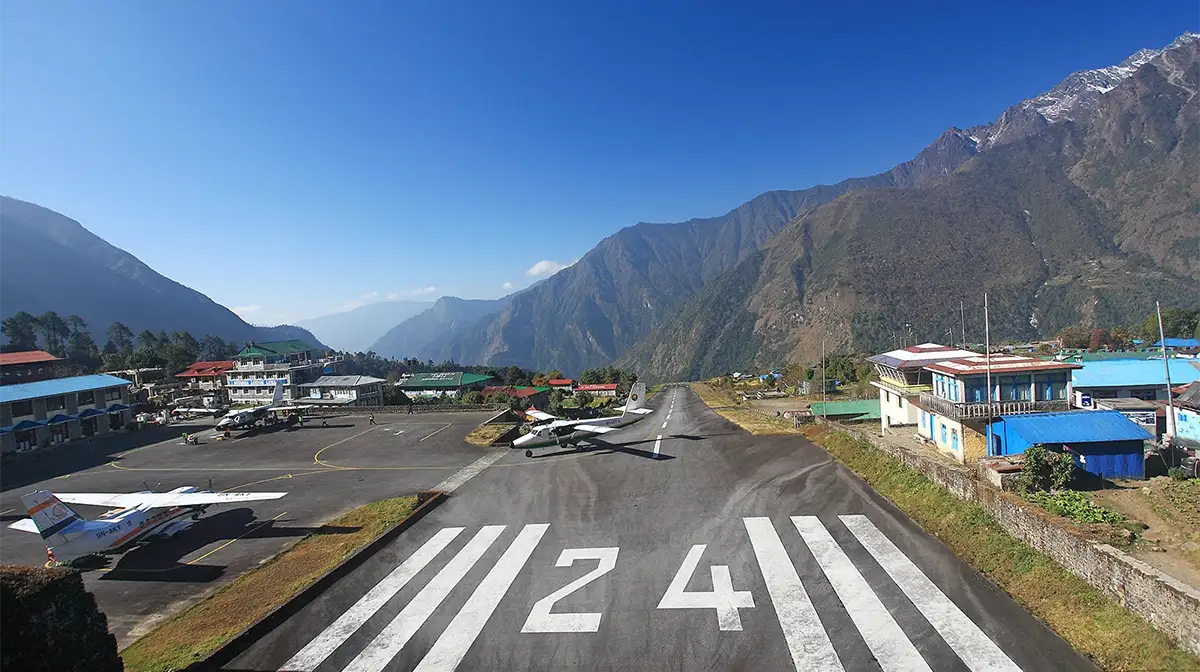A flight from Kathmandu to Lukla, lasting between 30 to 40 minutes, lands us in the quaint town at the base of Mt. Everest. Known as one of the most challenging airports globally, Lukla’s Tenzing-Hillary Airport serves as the primary entry point to the Everest region. Despite its brief runway, the airport bustles with activity, hosting up to 50 flights daily during the peak season!
Opting for a flight to Lukla offers a significant time-saving alternative to the several days of trekking otherwise needed to reach this point. This renowned airport owes its existence to the tireless efforts and contributions of the local community, not the government of Nepal. The motivation for its construction came from Sir Edmund Hillary, the first to reach Everest’s summit alongside Tenzing Sherpa, who recognized the lengthy journey to the trailhead could be vastly improved. The dedication and hard work of the villagers thus made the realization of this airport possible.
Lukla Airport
Tenzing-Hillary Airport, widely known as Lukla Airport, stands in Lukla town, nestled in Nepal’s rugged eastern landscape, and serves as the pivotal entry point to the Everest region. At 2,845 meters above sea level, it ranks among the world’s highest airports and offers a dramatic launchpad for expeditions to Earth’s tallest mountain. More than just a stopover, Lukla Airport, with its deep connections to the history of Himalayan exploration, attracts adventurers and travelers from across the world.
Lukla airport photos showcase the striking setting of this aviation gateway, surrounded by the Himalayas’ towering peaks. These images bring to life the breathtaking beauty and daunting challenges of its location. Over the years, Lukla has experienced notable incidents, including the “Lukla airport crash,” highlighting the demanding terrain and weather conditions that contribute to its reputation as one of the most difficult airports for landings and takeoffs. Despite these risks, flights to Lukla airport remain in high demand as they are the main route for trekkers and climbers venturing into the famous trails of the Everest region, underscoring the airport’s lasting appeal in adventure travel lore.

Lukla Weather
The unpredictability of weather at Lukla Airport notably complicates flight operations, leading to frequent cancellations under adverse weather conditions. The airport needs more sophisticated radar systems and air navigation facilities, contributing to the rapid deterioration of weather. Clouds often accumulate swiftly, drastically reducing visibility. The high-altitude setting of Lukla Airport, coupled with low air pressure, presents significant challenges for aircraft handling. Consequently, flights from Kathmandu to Lukla typically depart early in the morning when the skies are clearest.
Past incidents at Lukla Airport, attributed to its short runway, changeable weather, and irregular terrain, highlight the risks involved. Pilots rely on visual cues for takeoff and landing due to the absence of navigation aids, and sudden airport closures frequently occur when visibility drops below the thresholds of Visibility Flight Rules (VFR). The volatile weather and quick-forming fog over the short runway heighten the risk of accidents.
However, when weather conditions are favorable, the journey to Lukla becomes an exhilarating experience. The flight from Kathmandu to Lukla, especially on a clear, sunny day, offers an awe-inspiring introduction to natural beauty, filling travelers with a sense of wonder. The majestic mountain vistas and the diverse Himalayan landscapes warmly welcome everyone who traverses this route.
Everest Base Camp Trek
Luxury Everest Base Camp Trek
Everest Base Camp Trek for Beginners
Challenges and Safety Concerns at Lukla or Tenzing Hillary Airport
Short and Sloping Runway: A Pilot’s Dilemma
Lukla Airport presents a major challenge with its exceptionally short runway, one of the shortest in the world at 460 meters (1,509 feet). Compounding the difficulty is the runway’s 12% uphill gradient, making takeoffs and landings particularly challenging for pilots.
Weather Whims: Nature’s Unpredictability
The weather at Lukla is notoriously fickle, with sudden occurrences of fog, rain, and strong winds. Pilots must make quick decisions in this unpredictable environment, balancing the need to navigate safely through adverse weather conditions.
Altitude and Oxygen Deprivation: A Hazard
The high altitude of Lukla, situated at approximately 2,860 meters (9,383 feet), poses another risk. The thin air leads to decreased engine performance, adding another layer of complexity to aircraft operations during takeoff and landing.

Safety Measures: Navigating Lukla Airport’s Challenges
Stringent Training and Certification for Pilots
To address the unique challenges of Lukla, pilots must undergo extensive training and obtain specific certifications. This preparation includes mastering operations on short runways and honing mountain flying skills, equipping them to navigate the demanding conditions of the airport safely.
Implementing Strict Weight Restrictions
At Lukla, adhering to strict weight limitations is critical for aircraft safety. These measures prevent overloading, facilitating safer takeoffs and landings by ensuring aircraft are within operational limits.
Enhanced Monitoring and Communication
Continuous monitoring and clear communication channels are vital at Lukla Airport. Air traffic controllers closely track flights and communicate with pilots to assist with safe navigation during approach and departure, aiding in effective real-time decision-making.
Despite its daunting challenges, safety is the foremost concern at Lukla’s Tenzing Hillary Airport. Through advanced technology, pilot proficiency, and rigorous safety protocols, the airport prioritizes the well-being of both passengers and crew, enabling safe passage for those embarking on Himalayan adventures.

Flights to Lukla Airport
Tara Airlines, Sita Air, and Summit Air are the main operators of flights from Kathmandu to Lukla, with Goma Airlines and Simrik Airlines having ceased their Lukla services. Tara Air, founded in 2009, operates with a fleet sourced from Yeti Airlines, consisting of seven STOL (Short Takeoff & Landing) aircraft, including five Twin Otter DHC 6/300 and two Dornier DO 228, each capable of carrying up to 13 passengers.
Summit Air, initially known as Goma Air launched its operations in 2011 and rebranded itself as Summit Air in 2017. Beginning with two Cessna Grand Caravan 208 B, it expanded its fleet to include Turbolet LET-L 410 UVPE-20 STOL aircraft in 2014, accommodating 19 passengers per flight.
Since 2003, Sita Air has been a prominent domestic carrier in Nepal, offering both scheduled and charter services. The airline operates with four Dornier DO-228 STOL HERO aircraft, each designed to carry 13 passengers, maintaining a steady service to the challenging Lukla route.
Interesting facts about Lukla Airport
- Peak Season Activity: Lukla Airport witnesses as many as 50 flights daily during peak trekking and climbing seasons, underscoring its significance as a hub for adventurers heading to Everest.
- A Tribute to Mountaineering Legends: In 2008, the authorities renamed Lukla Airport to Tenzing Hillary Airport to honor Sir Edmund Hillary and Tenzing Norgay, the first confirmed climbers to conquer Mt. Everest.
- Geographic and Operational Challenges: Due to its altitude, geographical positioning, and notably short runway, Lukla is recognized as one of the world’s most dangerous airports.
- Unique Runway Setting: A massive mountain wall at one end and a steep valley drop at the other uniquely position the airport, adding to its notorious landing and takeoff challenges.
- Historical Path to Lukla: Before Lukla Airport’s establishment, the only route to Lukla from Kathmandu involved a road journey to Jiri, followed by a five-day hike.
- Evolution of Lukla Airport: The construction of Lukla Airport commenced in 1964, with operations starting in 1971 and runway paving completed in 2001.
- Runway Dimensions: Lukla’s runway, stretching 527 meters (1,729 feet) in length and 20 meters (65 feet) in width, presents unique operational challenges for aircraft.

Lesser-Known Facts About Lukla Airport
- Runway as a Pedestrian Path: The vital runway also serves as a passage for pedestrians crossing from one side to the other.
- Sir Edmund Hillary’s Initiative: Sir Edmund Hillary’s efforts, rather than those of the Nepalese government, are credited with the construction of Lukla Airport.
- Land Acquisition Story: The airport sits in its current location because Sir Edmund Hillary bought the land from local Sherpas for $2,650 after they refused to surrender their farmlands.
- Sherpa Contribution: The Sherpa community, famed for their mountaineering prowess, played a crucial role in building the airport alongside Sir Edmund Hillary.
- Navigational Practices: Lukla Airport operates without air navigation or radar systems, relying solely on radio communication for aircraft landings and departures.
- Notoriety in Aviation: For over 20 years, Lukla Airport has been featured by The History Channel’s ‘Most Extreme Airports’ as the world’s most dangerous airport.
- Weather Uncertainties: The weather at Lukla Airport is notoriously unpredictable, often leading to last-minute disembarkations even before takeoff.
Accommodation and Services in Lukla: Ensuring a Comfortable Stay
Accommodation Options
In Lukla, travelers can find a wide range of accommodation options, from cozy teahouses to comfortable guesthouses and upscale lodges, catering to the overnight needs of visitors. Trekkers often choose teahouses for their simple, charming rooms and hearty meals. In Lukla Airport, guesthouses commonly feature private rooms with en-suite bathrooms, providing additional comfort. Luxury-seekers will find various lodges in Lukla that boast rooms equipped with contemporary comforts, including hot showers and Wi-Fi access.
Essential Services
Lukla also offers a variety of essential services to enhance the convenience of its visitors.
- Restaurants and Cafes: A selection of restaurants and cafes in Lukla serve both local and international dishes, perfect for replenishing energy post-trek.
- Shops and Supplies: Trekking gear, clothing, snacks, and other essentials are available in Lukla’s shops, making it unnecessary for travelers to bring everything from home.
- Medical Facilities: With clinics and pharmacies on-site, Lukla provides necessary healthcare services and medications for minor or altitude-related health issues.
- Communication: Internet cafes and phone services in Lukla help travelers stay connected with family or manage their travel arrangements.
- Money Exchange: Currency exchange services are readily available, allowing travelers to convert their funds into Nepalese Rupees easily.
- Porter and Guide Services: Hiring porters and experienced guides in Lukla is straightforward, aiding trekkers in their ascent to Everest.
Lukla, serving as the gateway to the Tenzing Hillary Airport, ensures that travelers have access to a range of accommodations and essential services, making the start of their Himalayan expedition both comfortable and convenient.

Is flying to Lukla fraught with risk?
Indeed, flying to Lukla carries its inherent risks. However, a closer examination of records reveals that the dangers may not be as pronounced as some believe. Lukla’s reputation as one of the world’s most dangerous airports stems from its challenging topography, unpredictable weather, compact size, and the volume of air traffic, coupled with the notably short runway.
The primary concern at Lukla Airport is the rapidly changing weather conditions. Aside from this, the flight to Lukla presents minimal risk. The airport accommodates only helicopters and small, fixed-wing propeller planes, given the specific operational demands. Embarking on a journey to Lukla offers the genuine excitement of travel, making it a worthy endeavor. Furthermore, Lukla serves as the essential starting point for those bound for Everest Base Camp or Gokyo Ri. This flight becomes nearly indispensable, with alternative routes involving longer journeys, such as driving to Jiri, Phaplu, or Salleri.










